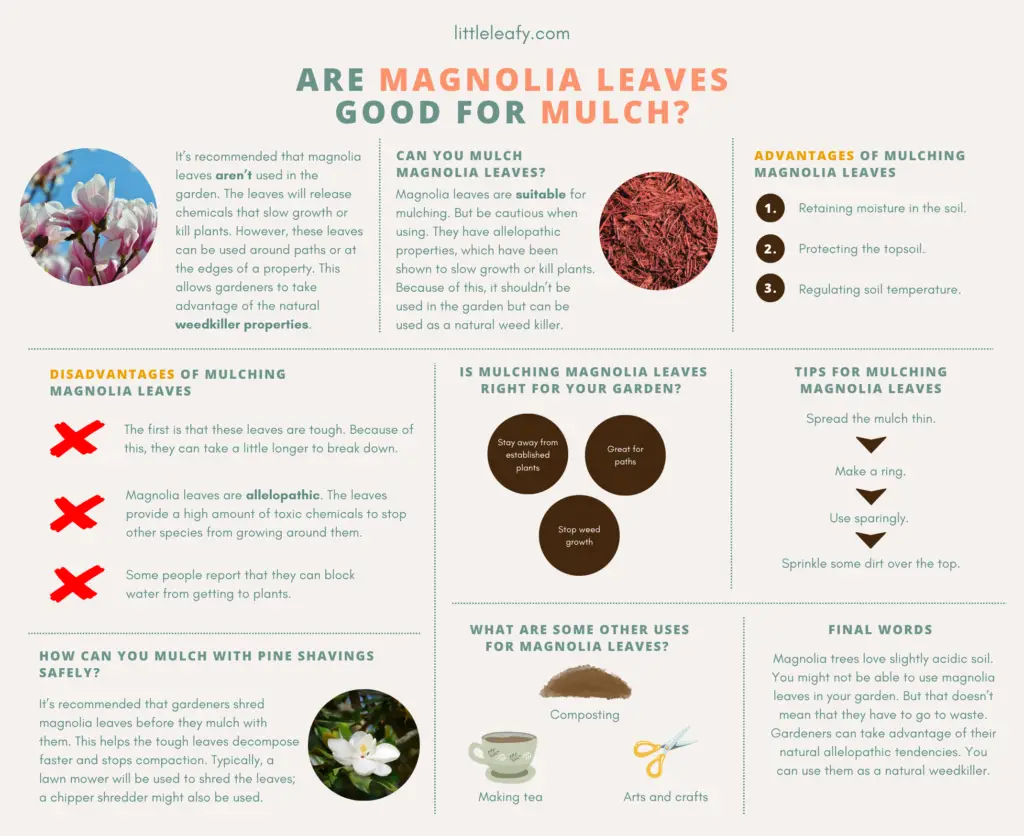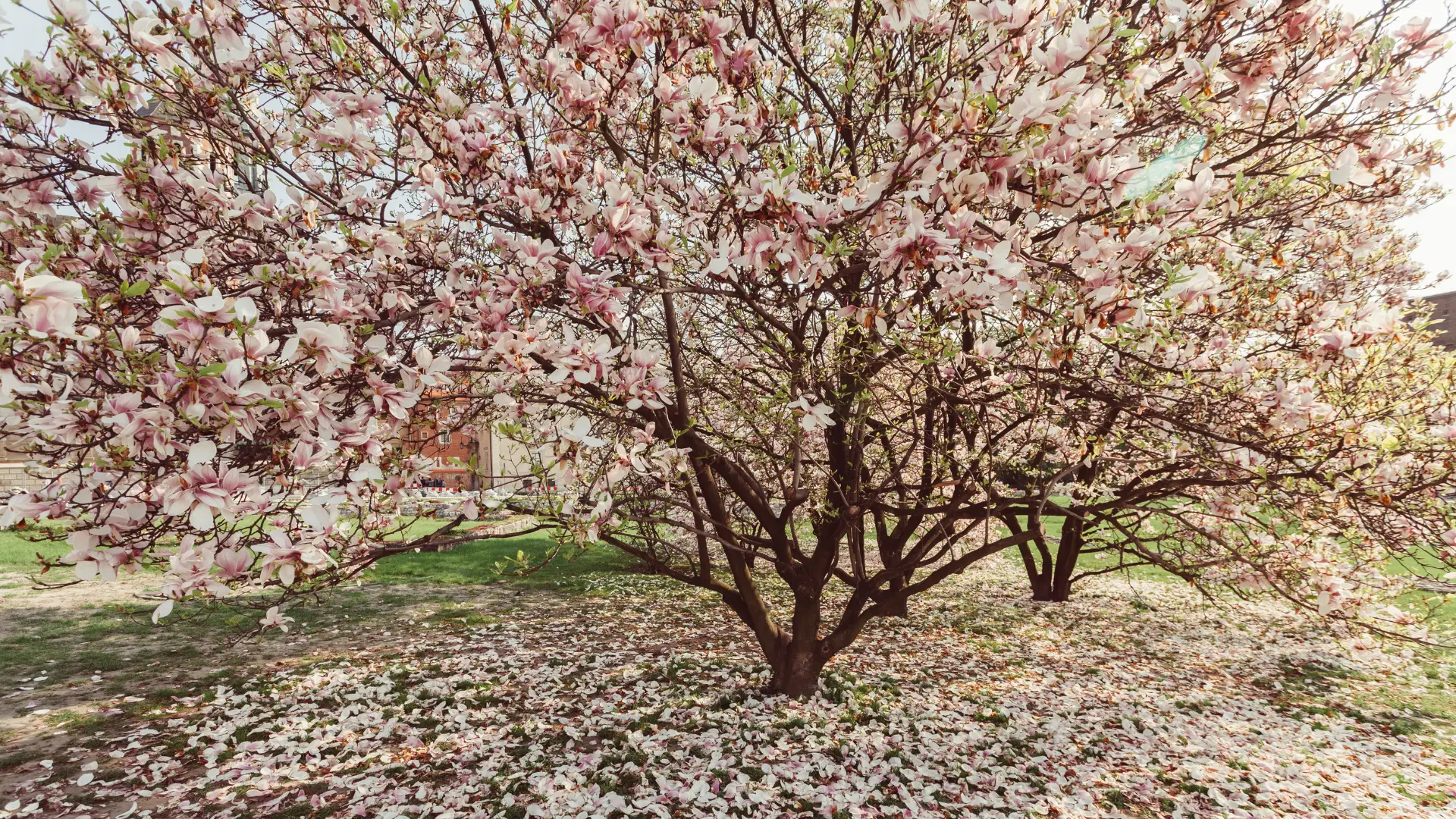Reading Time: 5 minutes 🍃
If you have a magnolia tree in your backyard, you know it can shed many leaves. There are a few things you can do with them. You might want to add them to the compost heap or throw them away. But are magnolia leaves suitable for mulching?
It’s recommended that magnolia leaves aren’t used in the garden. The leaves will release chemicals that slow growth or kill plants. However, these leaves can be used around paths or at the edges of a property. This allows gardeners to take advantage of the natural weedkiller properties.
When used correctly, magnolia leaves are an excellent resource for your garden. However, due to their allelopathic nature, you will need to be careful about how you use them. Otherwise, you could be inadvertently damaging your plant’s growth. Keep reading to learn about how you can mulch magnolia leaves.

Can You Mulch Magnolia Leaves?
Magnolia leaves are suitable for mulching. However, gardeners are urged to be cautious about where they use it. It has allelopathic properties, which have been shown to slow growth or kill plants. Because of this, it shouldn’t be used in the garden but can be used as a natural weed killer.
Before you start mulching these leaves, there are a few pros and cons that you should consider.
Advantages Of Mulching Magnolia Leaves
There are plenty of reasons why mulching is a good idea. These include:
- Retaining moisture in the soil. The thick protective layer of mulch will slow the evaporation rate. As a result, you will need to water less frequently.
- Protecting the topsoil. Mulch will help stop the topsoil containing valuable nutrients from getting blown or washed away.
- Regulating soil temperature. As you head into the winter months, you might want to add mulch to your garden. This helps raise soil temperatures to help your plants survive a harsh winter.
One of the most common reasons you might want to use leaves as mulch is to release nutrients into the soil slowly. In this case, magnolia leaves are high in nitrogen. This is important for plant growth.
Disadvantages Of Mulching Magnolia Leaves
While mulching magnolia leaves has some benefits, there are some big downsides for you to consider. The first is that these leaves are tough. Because of this, they can take a little longer to break down.
However, the bigger problem is that magnolia leaves are allelopathic. This is a natural way for plants to protect themselves. The leaves provide a high amount of toxic chemicals to stop other species from growing around them and sucking nutrients out of the soil.
These chemicals are released as the leaves break down. From there, they will leach into the soil, stopping plant growth. According to studies , the chemicals in magnolia will have a bigger impact on root growth than on shoot growth. This means that they should be kept away from established plants. It should be noted that while these leaves can damage plants, they are unlikely to be harmful to kids or pets.
, the chemicals in magnolia will have a bigger impact on root growth than on shoot growth. This means that they should be kept away from established plants. It should be noted that while these leaves can damage plants, they are unlikely to be harmful to kids or pets.
Finally, some people report that they can block water from getting to plants. This is because of how thick the leaves are and how long it takes for them to break down.
Is Mulching Magnolia Leaves Right For Your Garden?
You can mulch magnolia leaves. But you will need to be a little more selective about how you use it. Here are some of the tips you should use when applying magnolia mulch:
- Stay away from established plants. It’s recommended that you don’t use this type of mulch in your garden. The allelopathic properties risk slowing growth or killing plants outright. Though some hardy species, like Coyote Mint and Hummingbird Sage, might be able to tolerate these conditions.
- Great for paths. While you shouldn’t use them in your garden, many people will use magnolia leaves for paths.
- Stop weed growth. Some gardeners opt to use their allelopathic nature for good. Magnolia leaves are a great way of controlling unwanted weed species without needing harmful chemical sprays.
How To Prepare Magnolia Leaves For Mulching
It’s recommended that gardeners shred magnolia leaves before they mulch with them. This helps the tough leaves decompose faster and stops compaction. Typically, a lawn mower will be used to shred the leaves; a chipper shredder might also be used.
If you want to use Magnolia leaves in your garden, you’ll need to prepare the leaves accordingly. It’s recommended that you break them down before you put them into your garden. This will speed up the decomposition process. Plus, it will stop them from compacting, ensuring water is getting to the roots.
There are some simple ways that you can break down these leaves. First, you can use your lawn mower. If possible, use the bag attachment, which will make cleaning the leaves much easier. If your lawn mower doesn’t have the bag attachment, you can rake up the leaves later. Another option is to use a chipper shredder machine.
You can also rake up the leaves and place them in a garbage bin. The bin should be a third full. Then, you can use a string trimmer to shred them. This video walks you through this process.
Tips For Mulching Magnolia Leaves
If you are planning on using magnolia leaves for mulch, you need to keep a few things in mind. These include:
- Spread the mulch thin. Remember, these thick leaves will take a while to decompose. Because of this, you won’t need to use a thick layer of mulch to see results. Plus, this will ensure that water can still pass into the soil.
- Make a ring. If you are going to use mulch around trees or plants, you should spread it out into a ring rather than piling it around the base.
- Use sparingly. A small number of magnolia leaves, mixed into other types of compost, should be fine for your garden.
- Sprinkle some dirt over the top. If the thick, waxy leaves are taking too long to break down, you can put a few inches of dirt over the top. This will speed up the decomposition process as worms eat through the leaves.
What Are Some Other Uses For Magnolia Leaves?
Magnolia leaves can be used to make garden compost. Because they are so tough, it’s recommended that gardeners shred them first. Alternatively, Magnolia is associated with healing properties, so some cultures might want to use the leaves to make tea.
Magnolia trees are known for producing a lot of leaf litter. If you have too much for mulching, there are a few other ways that you can use these leaves. This includes:
- Composting. In the compost pile, worms and other good bacteria will help the leaves decompose. This reduces the allelopathic properties of the leaves, so they will be safe to use in your garden. Shredding the leaves first so that they will decompose faster is a good idea.
- Making tea. In Chinese culture, Magnolia trees are said to possess healing properties. It’s primarily used to help ease depression and anxiety. While bark and flowers are often used, some people like to make tea from the leaves.
- Arts and crafts. Due to their large size and green color might be used for some arts and crafts projects.
Final Thoughts
Magnolia trees love slightly acidic soil. You might not be able to use magnolia leaves in your garden. But that doesn’t mean that they have to go to waste. Gardeners can take advantage of their natural allelopathic tendencies. You can use them as a natural weedkiller, controlling invasive species without the use of harsh chemicals.
Sources
- https://www.gardenguides.com/article-magnolias.html

- https://www.permaculturenews.org/2016/01/21/plant-allelopathy/

- https://www.sciencedirect.com/science/article/pii/S0305197807001482

- https://homeguides.sfgate.com/flowers-grow-under-magnolia-66812.html

- https://www.sciencedirect.com/science/article/pii/S0301479716302535

- https://www.webmd.com/vitamins/ai/ingredientmono-188/magnolia


